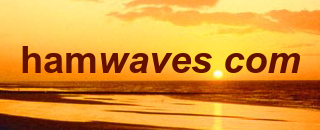Sector Boundary Crossings
Serge Y. Stroobandt, ON4AA
Copyright 2019–2024, licensed under Creative Commons BY-NC-SA
- Home
- HF Propagation
- Sector Boundary Crossings
Solar wind velocity
The solar wind velocity only considers the stream of solar charged particles with a kinetic energy between 0.5 and 10 keV. These are released from the solar corona and consist mainly of electrons, protons and alpha particles. Relativistic electrons are not considered in solar wind velocity statements. Two fundamental solar wind velocity states can be discerned: the slow and the fast solar wind.
Wang-Sheeley-Arge (WSA)‑Enlil model of the current solar wind velocity. (updated several times a day) Source: NASA
Solar wind density
The Wang-Sheeley-Arge (WSA)‑Enlil model of solar wind density also predicts the number of days until the next sector boundary crossing. The model also shows the more dense streams of solar wind which is slow solar wind and twice as dense and more variable in nature than fast solar wind. Other distinguishing characteristics of solar wind types are described in the next section.
Wang-Sheeley-Arge (WSA)‑Enlil model of the current solar wind density. (updated several times a day) Source: NASA
Slow solar wind
In near-Earth space, the slow solar wind shows a velocity of 300–500 km/s and an extremely high temperature of 1.4–1.6·106 K. The slow solar wind composition closely matches that of to the corona where it originates from.
Fast solar wind & CIRs
By contrast, the fast solar wind has a faster velocity of about 750 km/s and a much lower temperature of 8·105 K. Its composition is characteristic of the Sun’s photosphere, as fast solar wind originates from coronal holes. Coronal holes are funnel-like regions of open magnetic field lines which peer through the Sun’s hot chromosphere, and allow one to look down at the cooler photosphere.
Relativistic electron fluency
As mentioned before, electrons at relativistic speeds are not taken into account for determining the solar wind velocity. Nonetheless, a non-linear correlation exists between the relativistic electron flux and the solar wind velocity.1

Observed daily relativistic (> 2 MeV) electron fluency and forecast. Source: USAF & NOAA
Real‑time IMF & solar wind
The solar wind interplanetary magnetic field is a three dimensional vector, \(\vec{B_t}\), with components \(B_x\), \(B_y\) and \(B_z\). The vertical plane to the ecliptic is the \(B_y\), \(B_z\) plane, whereas \(B_x\) is the component on the Sun-Earth line. When \(B_z\) has a negative or southward orientation, the coupling to the Earth’s geomagnetic field is at its strongest. Southward interplanetary magnetic conditions are associated with geomagnetic storm activity.2 Because when the IMF is southward, antiparallel fields near the magnetospheric subsolar point allow for merging between the IMF and geomagnetic fields. This process increases the transport of solar wind mass, momentum, and energy into the Earth’s magnetosphere. This process can also open the magnetosphere to solar energetic particle radiation.3


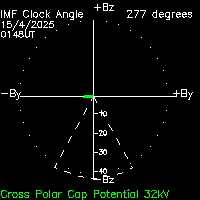
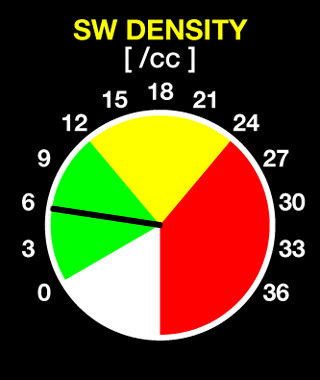
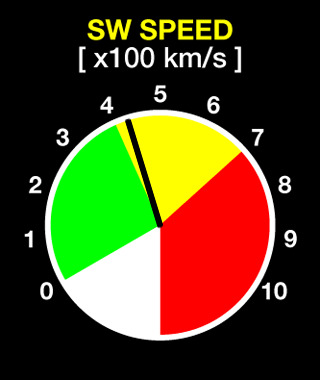
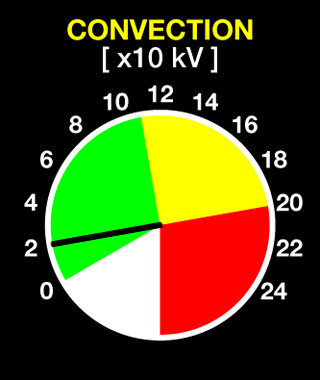
Shown above:
- The polar angle of the interplanetary magnetic field \(\vec{B_t}\), indicated in red when the \(B_z\) is negative (updated by the minute)
- The real‑time interplanetary magnetic field azimuth \(\phi\), used to detect SBCs. Noon (towards the Sun) corresponds to 0° or 360°, dawn 90°, midnight (away from the Sun) 180° and dusk 270° (updated by the minute)
- The real‑time interplanetary magnetic field \(B_z\) component (red when negative; updated by the minute)
- The solar wind density (updated by the minute)
- The solar wind speed (updated by the minute)
- The cross polar cap potential (CPCP) or convection potential induced by the solar wind crossing Earth’s magnetosphere (updated by the minute)
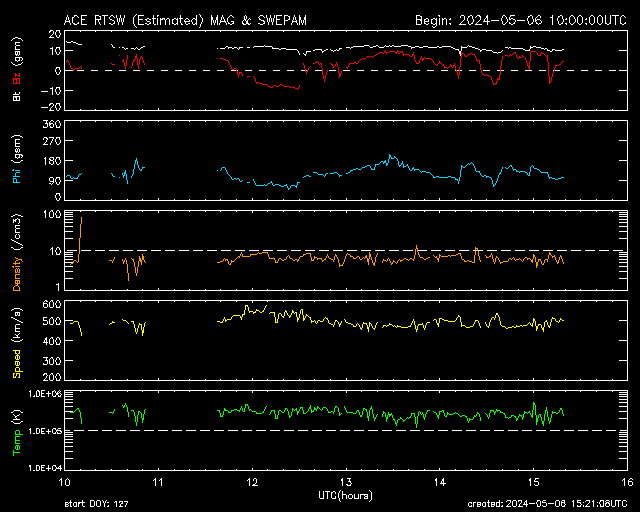
Real‑time interplanetary magnetic field and solar wind as measured by the NASA Advanced Composition Explorer (ACE) satellite. Phi is the azimuth of the IMF. (6 hour view; updated by the minute) Source: NOAA
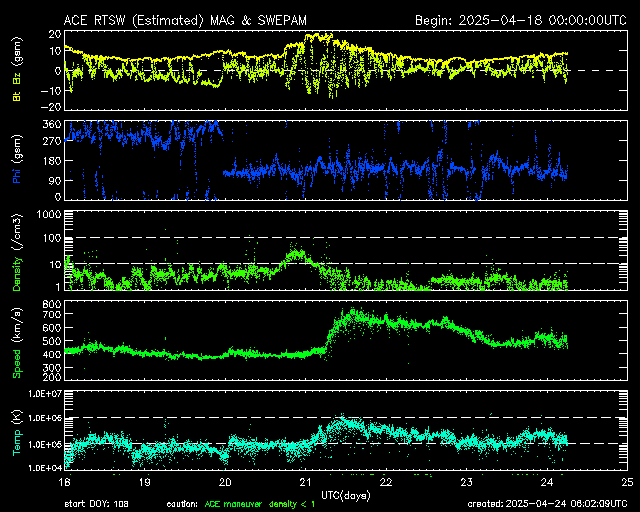
Real‑time interplanetary magnetic field and solar wind as measured by the NASA Advanced Composition Explorer (ACE) satellite. Phi is the azimuth of the IMF. (7 day view; updated by the minute) Source: NOAA
References

This work is licensed under a Creative Commons Attribution‑NonCommercial‑ShareAlike 4.0 International License.
Other licensing available on request.

Unless otherwise stated, all originally authored software on this site is licensed under the terms of GNU GPL version 3.
This static web site has no backend database.
Hence, no personal data is collected and GDPR compliance is met.
Moreover, this domain does not set any first party cookies.
All Google ads shown on this web site are, irrespective of your location,
restricted in data processing to meet compliance with the CCPA and GDPR.
However, Google AdSense may set third party cookies for traffic analysis and
use JavaScript to obtain a unique set of browser data.
Your browser can be configured to block third party cookies.
Furthermore, installing an ad blocker like EFF's Privacy Badger
will block the JavaScript of ads.
Google's ad policies can be found here.
transcoded by
 .
.
